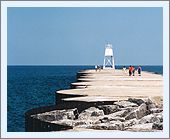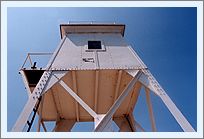|
Historical Information

"Big Marsh" is the direct
translation of the French "Grand Marais." While the name was
given by Voyageurs in the early seventeenth century, many subsequent
observers were puzzled, since no marshes have ever been known to exist
here. However, it is believed that the Voyageurs had their own unique
vocabulary, and it is likely that "Marais" referred to a cove,
or harbor of refuge. However, the historical importance trapping to the
area is indisputable, since both the Hudson's Bay Company and John Jacob
Astor's American Fur Company maintained a presence in the area over two
centuries. But it was not until Peter Barbeau established a trading post
on the bay in 1861 that a permanent settlement began to appear.
While the fur trade declined, lumber camps
began to spring up along Superior's south shore, and Grand Marais soon
found itself in the center of a lumbering boom, with stacks of lumber on
its docks awaiting the arrival of vessels to carry the forest's bounty
to the southern lakes.
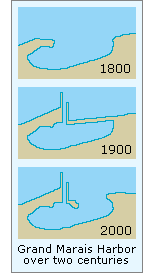 With
the associated increase in
maritime traffic through the late 1870's, the absence of a safe haven
for mariners coasting the treacherous waters between Whitefish Bay and
Grand Island became a matter of grave concern to maritime interests.
Deducing that the natural harbor could be modified to serve as an
excellent harbor of refuge, the Army Corps of Engineers embarked on an
ambitious harbor improvement project at Grand Marais in 1881. Work
continued over the following ten years, with the construction of a
5,770-foot timber pile breakwater stretching across the bay from
Lonesome Point to a dredged channel at the western shore. Two protective
piers were constructed on each side of the channel, and the protected
harbor area dredged to a depth of 40 feet, allowing access to the
protection of the harbor by the largest vessels of the day. With
the associated increase in
maritime traffic through the late 1870's, the absence of a safe haven
for mariners coasting the treacherous waters between Whitefish Bay and
Grand Island became a matter of grave concern to maritime interests.
Deducing that the natural harbor could be modified to serve as an
excellent harbor of refuge, the Army Corps of Engineers embarked on an
ambitious harbor improvement project at Grand Marais in 1881. Work
continued over the following ten years, with the construction of a
5,770-foot timber pile breakwater stretching across the bay from
Lonesome Point to a dredged channel at the western shore. Two protective
piers were constructed on each side of the channel, and the protected
harbor area dredged to a depth of 40 feet, allowing access to the
protection of the harbor by the largest vessels of the day.
As the forests close to the shore were
lumbered-out, operations moved west where timber could still be
harvested easily, and the Grand Marais mill ceased operations in 1884.
With the closing of the mill, the town's population decreased
dramatically, and turned to fishing to support itself, with Grand Marais
eventually becoming one of Superior's leading bluefin fisheries.
With the Corps of Engineers work on the
harbor of refuge nearing completion in 1892, the Light-House Board
determined that inbound navigation would be improved significantly with
the erection of a light and fog bell on the west pierhead. To this end,
the Board's annual report to Congress of that year included a request
for an appropriation of $15,000 for such a light.
The Manistique Railroad was completed
to Grand Marais in 1893, and with the resultant conduit for transporting
lumber from the virgin forests of interior, the town experienced another
period of rapid growth. The old mill was reactivated, enlarged and
outfitted with the latest equipment, and the harbor was once again
filled with lumber hookers, their decks stacked perilously high to
transport the lumber to feed the insatiable appetite of the rapidly
growing industrialized cities to the south.
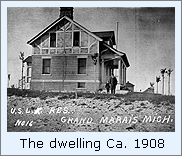 The wheels of the government machine
turned typically slowly, and the Congress was not forthcoming with the
requested appropriation for a pierhead light until March 2, 1895.
However, the Board reacted quickly to the appropriation, with plans and
specifications for a skeleton iron tower and elevated walk drawn-up, and
the awarding of contracts for fabrication of the tower's components. The
original estimate of cost included funds for the purchase of a new
fog-bell and striking
mechanism, however with the upgrading of the fog
signal at Point Iroquois from a bell to a steam-whistle being undertaken
that same year, the old Iroquois bell and mechanism was shipped to Grand Marais for
use in the new tower. The wheels of the government machine
turned typically slowly, and the Congress was not forthcoming with the
requested appropriation for a pierhead light until March 2, 1895.
However, the Board reacted quickly to the appropriation, with plans and
specifications for a skeleton iron tower and elevated walk drawn-up, and
the awarding of contracts for fabrication of the tower's components. The
original estimate of cost included funds for the purchase of a new
fog-bell and striking
mechanism, however with the upgrading of the fog
signal at Point Iroquois from a bell to a steam-whistle being undertaken
that same year, the old Iroquois bell and mechanism was shipped to Grand Marais for
use in the new tower.
Construction on the pierhead began that
same summer with the bolting of the tower's framework to the pier, and
upon completion in November, the new white painted tower stood
thirty-four feet tall, its octagonal iron lantern housing a sixth-order
fixed white Fresnel lens. Samuel Rodgers was transferred-in as the
station's first keeper, and he exhibited the light for the first time on
the night of December 10. Since no dwelling had been constructed to
accompany the station, Rodgers found himself forced to construct a
temporary shanty on Corps of Engineers property at the inner end of the
west pier.
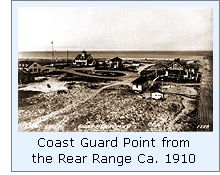 Perhaps as a result of the cost savings
resulting from the use of the old fog-bell machinery, or perhaps due to
the oversight of not building a keeper's dwelling, the project was
brought-in significantly under budget. Realizing that a second light to
form a rear range for the pierhead light would further improve
navigation into the harbor, the Lighthouse Board requested that the
unexpended portion of the appropriation be applied to the construction
of a rear range light to be located at the inner end of the west pier. Perhaps as a result of the cost savings
resulting from the use of the old fog-bell machinery, or perhaps due to
the oversight of not building a keeper's dwelling, the project was
brought-in significantly under budget. Realizing that a second light to
form a rear range for the pierhead light would further improve
navigation into the harbor, the Lighthouse Board requested that the
unexpended portion of the appropriation be applied to the construction
of a rear range light to be located at the inner end of the west pier.
Congress approved the redirection of
the balance on June 4, 1897, and District Engineer Major Milton B. Adams
awarded the contract for the fabrication of its components on September
27th. The contractor delivered the ironwork at the Detroit depot that
November, however with winter setting-in, work did not begin at site
until June of 1898 when the lighthouse tender Amaranth delivered a work
crew and materials on the pier at Grand Marais.
After the installation of strengthening
timbers at the inner end of the pier to support the additional weight,
the prefabricated tower was erected and painted white to match the
pierhead light. Standing 55 feet in height, its octagonal iron lantern
with a focal plane of fifty-four feet, and the Rodgers exhibited the
lights together for the first time on or about July 15, 1898.
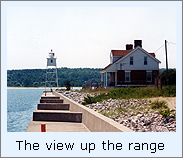 With traffic exploding along the south
shore, the frequency of maritime accidents increased proportionally. To
help guard the safety of mariners, 1898 also saw the beginning of
construction of a life-saving station at the foot of the west pier. On
its completion the following year, the station was considered one of the
finest in all of the Great Lakes, boasting 2 surf boats, a 34-foot
self-righting life boat, and a full complement of beach apparatus.
Doubtless, keeper Rodgers must have felt some resentment, as he watched
this fine new building take shape a few feet from the shanty that had
been his home for the past five years. With traffic exploding along the south
shore, the frequency of maritime accidents increased proportionally. To
help guard the safety of mariners, 1898 also saw the beginning of
construction of a life-saving station at the foot of the west pier. On
its completion the following year, the station was considered one of the
finest in all of the Great Lakes, boasting 2 surf boats, a 34-foot
self-righting life boat, and a full complement of beach apparatus.
Doubtless, keeper Rodgers must have felt some resentment, as he watched
this fine new building take shape a few feet from the shanty that had
been his home for the past five years.
In 1902, the Lighthouse Board finally
acknowledged the dismal conditions under which Rodgers was living, and
requested an appropriation of $5,000 for the construction of a proper
dwelling. The request was repeated for the following two years, however
Congress continued to turn a deaf ear to the request.
The Corps of Engineers continued their
work on the harbor, and as part of the ongoing improvements, the west
pier's length was extended an additional 612 feet in 1904.
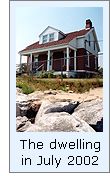 The combination of additional work
created by the second light, the dismal conditions under which he had
been living for the past nine years, and no indication that a dwelling
would be built at any time soon may have been more that Rodgers could
stand, since he resigned from lighthouse service on April 5th 1904.
George Barkley officially assumed responsibility for the station the
following day and was likely dismayed to find that he had to take up
residence in Rodgers' old shanty. The combination of additional work
created by the second light, the dismal conditions under which he had
been living for the past nine years, and no indication that a dwelling
would be built at any time soon may have been more that Rodgers could
stand, since he resigned from lighthouse service on April 5th 1904.
George Barkley officially assumed responsibility for the station the
following day and was likely dismayed to find that he had to take up
residence in Rodgers' old shanty.
 The following year, the front range
light was unbolted from the pier and moved 550 feet towards the newly
extended pierhead, and additional elevated walkway was installed to
connect the two lights. In concert with this move, the characteristic of
the lights were changed from white to red in order to better distinguish
them from the lights of the town behind the range. Again the Board
requested $5,000 for a dwelling, and again Congress ignored the request. The following year, the front range
light was unbolted from the pier and moved 550 feet towards the newly
extended pierhead, and additional elevated walkway was installed to
connect the two lights. In concert with this move, the characteristic of
the lights were changed from white to red in order to better distinguish
them from the lights of the town behind the range. Again the Board
requested $5,000 for a dwelling, and again Congress ignored the request.
Finally in 1908, Congress responded
with an appropriation of $5,000 to build the keepers dwelling, and a
contract was quickly awarded for the dwelling's construction. Work on
the structure began on June 10th of that same year, and was completed on
September 5, and was a duplicate of the dwelling constructed for the
Munising range lights the previous month. Doubtless, Barkley was happy
to move into the new dwelling, and abandon Rodgers "temporary"
shanty which ended-up serving the Grand Marais keepers for thirteen
years.
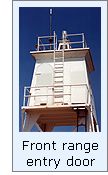 Lumbering and commercial fishing waned
on the south shore over the next twenty years, and the number of
commercial vessels entering Grand Marais harbor steadily declined. The
construction of the MacArthur Lock at the Soo in 1943 allowed larger
vessels to enter Lake Superior, and able to stay at sea in foul weather
that would have sent the smaller vessels of the past scurrying for
shelter, Grand Marais harbor became of decreased commercial importance.
The Corps of Engineers stopped maintaining the breakwater during the
1940's, and without constant care the wooden structure quickly rotted
away. Thus unprotected, the harbor began to fill with sand making entry
possible only for smaller vessels. Lumbering and commercial fishing waned
on the south shore over the next twenty years, and the number of
commercial vessels entering Grand Marais harbor steadily declined. The
construction of the MacArthur Lock at the Soo in 1943 allowed larger
vessels to enter Lake Superior, and able to stay at sea in foul weather
that would have sent the smaller vessels of the past scurrying for
shelter, Grand Marais harbor became of decreased commercial importance.
The Corps of Engineers stopped maintaining the breakwater during the
1940's, and without constant care the wooden structure quickly rotted
away. Thus unprotected, the harbor began to fill with sand making entry
possible only for smaller vessels.
Today, the Grand Marais Harbor is
frequented by pleasure craft, and the town is undergoing a resurgence as
it gains popularity as a four-season resort area. Both ranges are still
in place, however the lantern has been removed from the front range, to
be replaced by a modern acrylic lens. The keepers dwelling now serves as
a museum operated by the Grand Marais Historical Society, and is open to
the public from June to September.

Keepers of
this Light

Click here
to see a complete listing of all Grand Marais Range Light keepers
compiled by Phyllis L. Tag of Great Lakes Lighthouse Research.

Seeing this Light

We returned for our third trip to Grand Marais during our July 2002
field trip to find the harbor full of sea kayaks, which were holding
some type of festival that weekend. It was a beautiful day, and we
walked the full length of the pier to obtain close ups of both lights.
Since our previous trips to see these lights had been in September, we
were happy to see the keeper's dwelling museum was open, and we took the
opportunity to tour the beautifully restored building.

Finding this
Light

From the junction of M77 and County Road 702 in downtown Grand Marais,
take CR702 northeast approximately 1/2 mile. The rear range light can be
seen on the right of the road before the road ends in the parking lot of
the old Grand Marais lifesaving station.
The Pictured Rocks National Lakeshore Nautical and Maritime Museum is
located in the lifesaving station, and is well worth a visit. The pier
is a pleasant walk, and both lights are easy to see during good weather.

Reference
Sources

 Annual reports of the Lighthouse Board, 1892 - 1908 Annual reports of the Lighthouse Board, 1892 - 1908
Inventory of Historic Light Stations, National Parks Service,
1994
Personal observations and photography at Grand Marais, July 2002.
Photograph courtesy of Brian Malone.
Lake Superior's Shipwreck Coast, Frederick Stonehouse, 1986.
6/21/2001 email from Thomas Tag on the keepers of Grand Marais.
History of the Great Lakes, J.H. Beers Company, 1889
Great Lakes Pilot, First Station on Coast Guard Point, Fern
Erickson, 2000.
Email from Wayne Sapulski, 02/12/02
Lake Superior, Grace Lee Nute, 1944.
Historic postcard courtesy of Cathy Egerer.
Michigan State Archives lighthouse photograph collection.
Grand Marais, Website
Keeper listings for this light appear
courtesy of Great
Lakes Lighthouse Research
|
